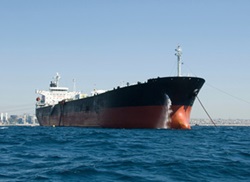Ships

Oil Tankers
Today's cutting-edge tanker ships are the products of a commitment to safety, combined with the power of computer-assisted design. These new ships are stronger, more maneuverable, and more durable than their predecessors.
Pilot Training
To reduce the risk of accidental groundings and spills, prospective tanker pilots use virtual reality technology to get extensive hands-on training before they ever take the wheel of a ship. A number of multi-million dollar training facilities feature full-scale models of tanker bridges, using full-surround video screens and stereophonic audio to recreate real-world situations. Computers are used to generate potential hazards, such as fishing boats, yachts, helicopters, and tugboats. Additionally, instructors in a nearby control room can increase the complexity of a training session by adding wind, fog, icebergs, or floating logs. Multiple simulators can be linked together as separate ships within a single scenario.
Double Hulls
By 2015, all tankers operating in U.S. waters will be double-hulled vessels. This hull-within-a-hull configuration provides an extra measure of security – in the unlikely event of a collision or grounding, the outer hull will bear the brunt of the impact while the interior hull will keep the cargo secure and prevent oil from entering the marine environment.
Redundant Systems
In an effort to build ships capable of withstanding even the most extreme circumstances, many tankers are now equipped with redundant, or duplicate, systems. If the original system is compromised, a second, fully functional system is on hand as a backup. This concept is put into use in navigation, with backup GPS systems, for example, and below decks in redundant engine rooms. Duplicate rudders and propellers have the added benefit of improved maneuverability, enabling the ship to rotate 360° in a fixed position.
Single Operator Capability
A highly trained bridge crew is the key to effective decision-making on the water. Once a decision is made, however, modern tankers allow a single deck officer to make all appropriate adjustments to the ship's speed and course from a central command station. This allows for faster response in critical situations.
Barges
Today's modern tugboats and towboats are equipped with state-of-the-art communication technology, propulsion systems, and powerful engines. Together with comprehensive personnel training regulations for licensing, the industry is making great strides in achieving greater industry safety, security, and environmental protection.
By 2015, all tank barges operating in U.S. waters will be double-hulled vessels. This hull-within-a-hull configuration provides an extra measure of security, in the unlikely event of a collision or grounding, the outer hull will bear the brunt of the impact while the interior hull will keep the cargo secure and prevent oil from entering the marine environment. The switch to double hulls is already well underway, as 80 percent of barges in service in 2005 were double-hulled and another 12 percent featured other forms of hull reinforcement.

